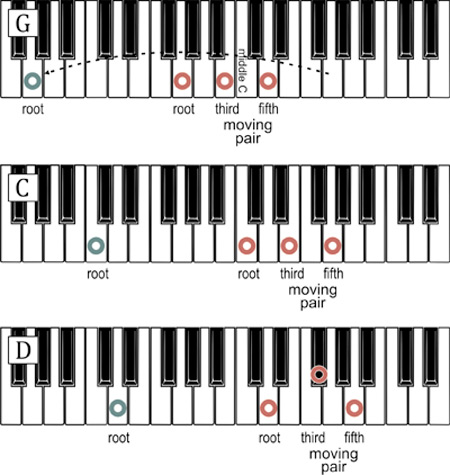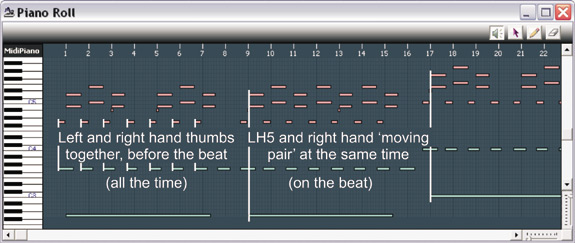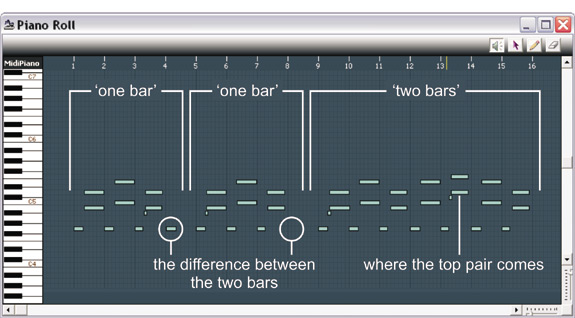Musicarta Twelve-bar Piano Styles
Moving Pair - Module Ten
‘Two pairs only – three right, bass left’
Plenty of blues-based rock music uses just the bottom two of the three ‘moving pair’ chords. The riff you’ll build up to in this module does just that.
‘Two pairs only’
In this riff we use just the bottom two moving pairs.

The notes are split up as follows
- The bottom three of the four notes in the right hand, and
- The left hand plays a root note an octave lower in the bass.
Find the G, C and D starting positions in this keyboard diagram.

Use right hand fingers 1, 2, 4 for the starting chords shown – so you have fingers for the next-door ‘moving pair’.
The basic riff
Listen to the most basic version of the module riff.
Try to play this version from the audio clip, the ‘starting positions’ diagram and the MidiPiano MIDI file performance (if you need it.)
You should have noticed that the riff is on the shuffle (‘swing quavers’, ‘triplet feel’) beat.
The recommended right hand ‘starting positions’ fingering 1, 2, 4 conveniently leaves right hand fingers 3 and 5 for the upper moving pair notes.
Listening for the overall pattern
Take a break to listen again to the overall pattern of the right hand part. Here’s a MIDI screen-shot of the whole chorus you’ve just heard and played.

Match up the screen-shot up and this chord sequence chart as you listen to the audio again.

(You can actually ‘see’ the chord structure in the MidiPiano screen-shot.)
The right hand pattern to notice is the ‘one bar, one bar, two bars’ pattern, which comes three times in the whole 12-bar chorus.

The ‘one bar, one bar, two bars’ pattern carries on even though the chords change. Listen to the simplified module riff audio again and read through this marked-up chord sequence.

An overall chorus pattern like this can help simple keyboard playing sound more sophisticated.
There is another, tiny difference between the first ‘one bar’ and the second ‘one bar’. patterns. Can you see-and-hear it? (Answers at the end of the module.)
‘Build-up’ in theory and practice
Building up musical excitement by developing a simple riff chorus by chorus is a common and effective technique. (It is also completely in line with Musicarta’s approved ‘performance build-up’ procedure!) If you have a great riff – perhaps for a full band – consider ‘unpacking’ it and introducing elements of the riff (and perhaps the instruments too) chorus by chorus.
Developing the bass line (1)
Start developing the basic riff. Pull the bass note forward of the beat. If you can stretch an octave, play the next root down on the beat with your left hand little finger. Throw some crushed grace notes into the right hand riff.
Use this MidiPiano ‘piano roll’ view to work out which fingers/notes come together.

Develop the bass line (2)
Add a run-up to the left hand thumb. The notes are the fifth and seventh (technically, the flattened or minor seventh).
These are the actual notes to use. R (root) is the chord name-note.

Note how the fifth-and-seventh combination sounds ‘rockier’ than the fifth-and-sixth combination you used before.
Re-introducing the third pair (optional)
In the second chorus on, the top ‘moving pair’ reappears. Listen closely to the module riff audio and see if you can hear where the top pair plays.
(This is good practice for learning songs by ear – answers at the end of the module.)
The top pair only comes three times in the whole chorus. Little variations like this stop simple music sounding boring.
The answers
This MidiPiano screen-shot below shows the two “Can you notice…?” features in this module.
- The ‘tiny difference’ between the first and second one-bar patterns, and
- Where the top pair comes – three times in the last chorus.
Here's the last build-up chorus. Look-and-listen again to identify the two features accurately. Having a picture of the music in your head, however fuzzy, makes it much more 'your own'.

Finally, here’s the module riff again. You should be able to play a reasonable version of it. Remember that keeping going is your first priority, so simplify until you can do that, then build up from there.
Module summary
You see from this module how elements of the Moving Pair material can be combined into new riffs.
- Not all the ‘pairs’ have to be played.
- The notes can be split up between the hands how you like.
The most important sentence in the module, however, is right at the end:
“Remember that keeping going is your first priority, so simplify until you can do that, then build up from there.”
The twelve-bar form is very compelling, and the keyboard player who can keep the choruses coming gains a great deal of enjoyment. This in turn becomes motivation to keep practising.
So, really –
“Simplify until you can keep going, and build up from there.”
Here's a video of the module riff. You can see from the hands that it's not difficult. It's just a matter of knowing where you have to get to and what you're going to do when you get there.
Having a clear picture in your head makes nearly everything do-able!
|
OUT NOW! |
THE MUSICARTA BEAT & RHYTHM WORKBOOK At last! An effective approach to keyboard rhythm & syncopation skills. Learn more! |
ONLY $24.95! |
TWELVE-BAR |
The MusicartaA methodical approach to keyboard syncopation for
|
PUBLICATIONS
exciting keyboard
creativity courses
CHORDS 101
WORKBOOK

~HANON~
video course

Musicarta
Patreon
PENTATONICS
WORKBOOK
video course

Creative Keyboard
video course

BEAT AND RHYTHM
WORKBOOK

- Volume 1 -

12-BAR PIANO
STYLES WORKBOOK

MUSICARTA MODES
WORKBOOK

PIANO STYLE

CANON PROJECT
video course

VARIATIONS
video course


- Piano Solo -
video course

- Piano Solo -


YouTube playlists





 THE LOGO
THE LOGO
